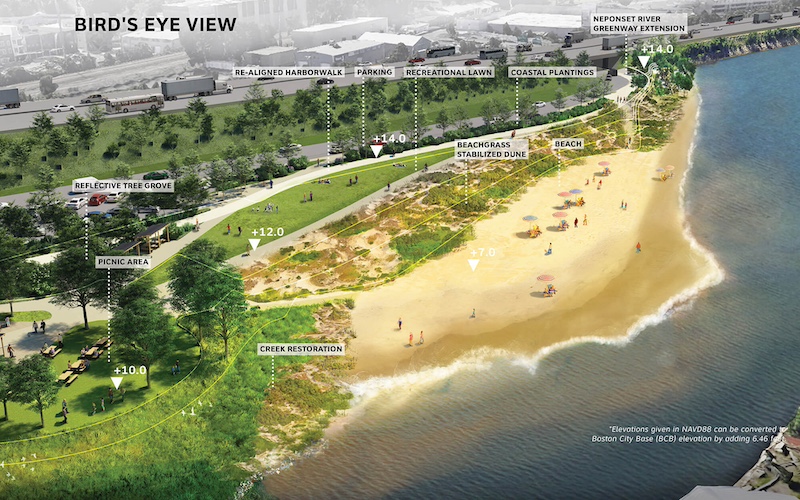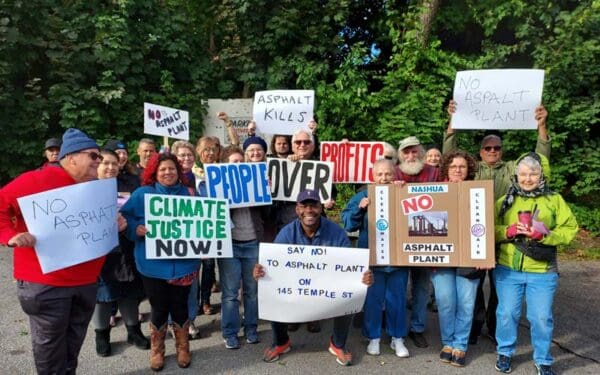
Boston's redesign of Tenean Beach in Port Norfolk is part of a broader climate resilience plan that is flagging. Image: courtesy of BPDA
In 2020, Boston had big plans for Dorchester’s Neponset/Port Norfolk neighborhood. The area sits right on the Neponset River and regularly floods during storms. The city, however, planned to solve that problem by 2030 by planting green spaces, building a “living” shoreline, and creating paths for area residents.
That reimagined coastline was part of Climate Ready Boston, an ambitious initiative to increase Boston’s resilience to climate change. Between 2017 and 2022, Boston planned dozens of similar projects that included parks, streets, and other infrastructure in coastal neighborhoods. Running from Dorchester to South Boston, through Downtown and the North End, to Charlestown, and over to East Boston, these plans were far-reaching. Total project costs were estimated at well over $4 billion, but it was understood that the initiative was critical to protecting the health and safety of area residents.
Unfortunately, for all the ambition and promise, there’s been little progress on Climate Ready Boston. Today, most of the climate projects recommended for completion by 2030 have yet to be included in Boston’s recent capital plans, including the current one, which extends to 2029. Last year, CLF urged the City Council to address this problem, but little has changed, and each year that the climate projects stall represents another year of preventable climate damage and loss. It’s also more hardship for Boston residents forced to deal with flooded streets and neighborhoods.
How could this happen?
What Doesn’t Work: Funding Climate Through Development
One important reason Boston has slowed its climate resiliency plans: Instead of funding these projects through municipal bonds and grants, Boston is relying on developers. The city hopes developers will incorporate many Climate Ready Boston projects into their plans. Much of Boston’s coastline is privately owned, so developers will inevitably play a role in climate resilience. But here is the folly in this arrangement: Relying on developers to fill funding gaps will leave many parts of Boston vulnerable to climate change.
Relinquishing control of resilience projects to private parties is risky. Developers may design a resilient project, but they aren’t incentivized to account for the broader needs of the neighborhood.
Today, this is creating an inefficient, piecemeal approach toward resilience, leaving many neighborhoods still vulnerable to flooding. Developers are also not beholden to the city’s timeline. The delays that can (and often do) occur during development put the city further behind, leaving neighborhoods that would benefit from the resilience measures in harm’s way. Moreover, developers aren’t equally interested in all neighborhoods. That leads to inequity, with areas deemed “undesirable” or lacking space missing out on these benefits.
In addition, some developments may move forward under the guise of resilience, even when they face substantial opposition from neighborhood residents. Boston’s climate resilience should not hinge on private interests.
A Different Path Forward
Boston must create a comprehensive equity-driven funding plan for Climate Ready Boston. A scan of the climate funding landscape reveals many different available sources. Touting development as the path to resilience ignores what every Boston resident knows: No two neighborhoods are the same. Each has different needs and contexts that should be reflected in the funding strategy.
Additionally, the city should recognize that there isn’t one option that will close this funding gap. Several funding sources must be pieced together to support an initiative of Climate Ready Boston’s scale. In neighborhoods like South Boston, the city can take advantage of the almost 50 ongoing projects by partnering with developers to implement resilience projects. This would allow the city to focus its funds and fund-seeking efforts on areas that cannot rely on private development, such as the North End, where only one development is in progress, or Dorchester, where fewer ongoing developments will leave sizable gaps in resilience.
Boston’s new stormwater fee can support additional resilience efforts in neighborhoods like Dorchester. For other projects, the city could explore different taxes or fees. For example, in Boulder, Colorado, voters approved a climate tax on natural gas and electricity providers, raising millions of dollars annually for climate resilience efforts. Since the tax is passed onto customers, Boulder has equity safeguards, such as exempting low-income energy assistance participants.
Funding from state and federal sources is also a good option, though each program has different requirements. For example, state and federal sources often have a cost-share requirement; Mayor Wu’s proposed Coastal Resilience Reserve budget would help address this potential barrier. Additionally, some FEMA programs are only available after a presidentially declared disaster. Should such an event occur in Boston, the city should have a ready-to-implement and prioritized list of projects to make use of these funds in an equitable way.
Climate Resilience Shouldn’t Be Left to Private Interests
Climate change poses a significant risk to the health and welfare of Boston residents. Although the Climate Ready Boston neighborhood plans were an important step toward climate resilience, progress on their implementation is overdue. However, Boston cannot rely on private interests. Instead, the city must develop a comprehensive equity-driven plan to address the funding gaps currently impeding climate plans. Boston residents deserve a city that is safe and resilient to climate change.




